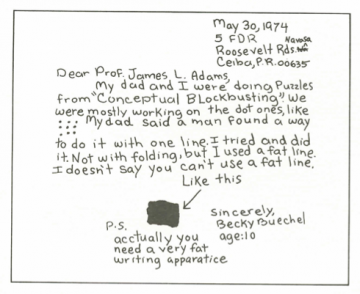What stands between us and our creative selves? This week we reviewed some perceptual blocks from one of my all-time favourite books by James Adams: Conceptual Blockbusting. Used some of the exercises as a studio warm-up. Blocks discussed were:
Stereotyping – Seeing What you Expect to See…e.g. think of how we used to relate hair-length in men to political persuasions – long hair meant radical and short hair meant conservative. No more. That stereotype, like most, is not accurate.
Difficulty in Isolating the Problem… e.g. problems that we face may be obscured by either inadequate clues or misleading information. And proper problem-identification is of extreme importance in problem-solving.
Tendency to Delimit the Problem Area Too Closely Just as it is tough to isolate problems, we also have a tendency to look at problems too narrowly. We used the 9 dots puzzle from Adam’s book. Instructions: Draw no more than four straight lines (without lifting the pencil from the paper) which will cross through all nine dots. This puzzle is tough to solve if the imaginary boundary (limit) enclosing the nine dots is not exceeded. Here is my favourite solution (again from Adam’s book):
Inability to See the Problem from Various Viewpoints… e.g. it is often difficult to see a problem from the viewpoint of all of the interests and parties involved. If we can empathize or stand in the shoes of the people we are working with to solve a problem – communication is better and the solutions are better. Part of the reason to think about extreme users.
Saturation… e.g. saturation takes place with all sensory modes. We just get overloaded. To illustrate – without looking at one, draw the number pad from a touch-tone phone, putting the letters and numbers in their proper locations. Very few people can do this exercise successfully, even though they have used phones for large proportion of their lives.
Failure to Utilize all Sensory Inputs…e.g. As problem-solvers, we need all the help we can get! We should be careful not to neglect any sensory inputs. Sound. Taste. Smell. Vision.
This week we also rolled out the final project brief for the Climate Smart project — will review that next week. We also did a quick review of the climate smart mapping project for each of the businesses. This served to get all of us a bit familiar with what the issues are in each of the business situations.
Finally, we had some guests…our speaker was John Tylee, Director of Policy and Planning for the Vancouver Economic Commission (VEC). We also welcomed Ron Kellett and students from the ENDS program in the School of Architecture and Landscape Architecture. John provided us with an incredibly useful presentation summarizing the work that the VEC has been doing as part of their role in meeting the two “green economy” targets: 20,000 jobs by 2020 and the greening of all jobs. Will do a separate blog on his presentation.
